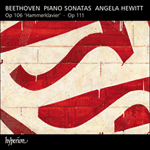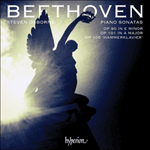
Welcome to Hyperion Records, a British classical label devoted to presenting high-quality recordings of music of all styles and from all periods from the twelfth century to the twenty-first.
Hyperion offers both CDs, and downloads in a number of formats. The site is also available in several languages.
Please use the dropdown buttons to set your preferred options, or use the checkbox to accept the defaults.


Composition of the sonata took longer than usual, partly because of its great size and complexity, and partly because Beethoven was still not back to full health. As with all his major works, he made numerous sketches and rough drafts in the course of composing the sonata, but unfortunately a large number of them are lost, including a complete sketchbook (the so-called ‘Boldrini’ sketchbook) that was described by Gustav Nottebohm before disappearing around 1890. Beethoven claimed that the first two movements of the sonata had been completed in time for Rudolph’s name-day in 1818 (17 April), and the sketches seem to bear this out, although he made adjustments at a later date. The remaining two movements were completed later in 1818, but were evidently ready by about the end of the year.
While working on the sonata Beethoven received the gift of a Broadwood piano from London, bearing the signatures of some of that city’s leading musicians. It was sent in January 1818 and reached him in late spring. Most Viennese pianos at that time had a six-octave compass (FF to f''''), but the Broadwood had a lower six-octave compass (CC to c''''), and it is noticeable that the first two movements of the ‘Hammerklavier’ use the Viennese range but the last two use the Broadwood range. The net result is that the sonata as a whole uses every single note of the combined six-and-a-half octaves, a feature not found in any of his other sonatas. It also uses every key signature from six sharps to six flats, except one (four sharps). This was not done systematically, but simply arose as a result of the enormous tonal scope of the work.
Manuscript copies of the sonata were prepared around January 1819 and sent to two publishers—one in England (The Regent’s Harmonic Institution) and one in Vienna (Artaria & Co)—and both publishers issued it later that year with the dedication to Archduke Rudolph. Unfortunately, the ‘Hammerklavier’ is the only one of Beethoven’s late sonatas whose autograph score is lost, as are the two manuscript copies. The absence of these vital sources has led to considerable textual uncertainty in a few places, for neither printed edition is wholly reliable, even though Beethoven sent to England a correction list, most of which still survives. Most notorious are some natural signs that Beethoven forgot to add to all the As in bars 224-226 of the first movement (around 7'08 in this recording), leaving faulty A sharps that some pianists have observed too literally. Happily, this recording includes the notes Beethoven intended, rather than the faulty text that was printed in both original editions.
The ‘Hammerklavier’ is the only Beethoven sonata for which he supplied metronome marks. The metronome had been invented by Johann Nepomuk Maelzel around 1815, and Beethoven was the first major composer to make use of it to indicate precise speeds. He added metronome marks for all his symphonies, but he found the process tiresome and failed to produce them regularly for other works, even though he approved of the idea in principle. His metronome mark for the first movement of the ‘Hammerklavier’ is famous for being incredibly fast, and many musicians think it should be somewhat slower. This is how it is performed in this recording, to enable the intricate details to be better appreciated, although Beethoven’s pupil Carl Czerny said that the fast speed simply demands attentive practice.
Much of the sonata is based on rising and especially falling thirds. This is evident from the very first phrase, which begins with a rising third (albeit displaced by two octaves) and ends with a falling third. Beethoven uses these thirds at various levels—for example, the second main theme is in G major, a third lower than the B flat of the opening theme. The first movement is in sonata form, with a repeated exposition followed by development of some of the main ideas, then a recapitulation in which both main themes are now in the home key. A coda seems to be bringing the movement to a gentle, subdued ending, before two final loud chords emphasize the movement’s imposing character.
In most four-movement works the slow movement comes second, followed by a light-hearted minuet or scherzo; but where the first movement is particularly grand and majestic the scherzo works better if placed second, as here. As in the first movement, the opening phrase of the scherzo uses a rising third then a falling third. In most scherzos the first part consists of two repeated portions, but here the two repeats are an octave higher than the original version and slightly modified. The central part of the movement, sometimes known as the trio section, is in the minor, but again it begins with a rising then falling third. This section is then followed by a short presto section and a rapid ascending scale across the entire six-octave compass, before a slightly altered reprise of the opening section of the movement. The short coda veers abruptly into the improbable key of B minor, but returns equally abruptly to the home key.
The third movement is a passionate and highly expressive adagio in F sharp minor, a key Beethoven hardly ever used elsewhere, and its sad, somewhat tragic character is unmistakable, with long-drawn-out phrases and anguished dissonances. The opening melody begins with two successive falling thirds, intensifying the sense of dejection; however, after sending the work for publication, Beethoven astonishingly inserted a preliminary bar, consisting of a rising third, that cunningly links to the end of the previous movement while anticipating a similar motif later in the slow movement. This revision, which he sent to both publishers, is one of the most remarkable last-minute changes in the whole of music history. The movement as a whole is in sonata form, but with decorated recapitulation, and the extraordinarily low-pitched secondary theme is again placed in a key (D major) that is a third lower than the opening theme.
After such a profound movement, Beethoven produced an extended introduction to the finale—an introduction where time initially seems to stand still and there are not even any bar lines. A few fragmentary ideas follow, leading to an unaccompanied theme that heralds the start of a three-voice fugue of incredible complexity. The three-voice texture is maintained strictly until very near the end, but the part-writing is so dense that it often sounds like more than three voices. The main theme appears repeatedly, but sometimes upside down (inversion), back to front (retrograde) or at half speed (augmentation), requiring an astute listener to spot all the different versions. Suddenly the music stops and a new, gentler theme is developed, before being combined ingeniously with the original theme to add to the overall complexity. The fugue concludes with the initial three-note motif heard repeatedly in unison, each time one degree higher, leading to a final fortissimo cadence.
from notes by Barry Cooper © 2024
La composition de cette sonate prit plus de temps qu’à l’ordinaire, en partie à cause de ses dimensions et de sa complexité, mais aussi parce que Beethoven n’avait pas encore retrouvé sa pleine santé. Comme pour toutes ses œuvres majeures, il fit beaucoup d’esquisses et de brouillons au cours de la composition de cette sonate, mais malheureusement un grand nombre d’entre eux sont aujourd’hui perdus, notamment tout un carnet d’esquisses (le carnet d’esquisses dit «Boldrini») décrit par Gustav Nottebohm avant de disparaître vers 1890. Beethoven affirma que les deux premiers mouvements de la sonate avaient été achevés à temps pour la saint Rodolphe en 1818 (le 17 avril) et les esquisses semblent le confirmer, mais il fit des modifications à une date ultérieure. Les deux autres mouvements furent achevés plus tard en 1818, mais furent apparemment prêts vers la fin de l’année.
Pendant qu’il travaillait à cette sonate, Beethoven reçut en cadeau un piano Broadwood de Londres, portant les signatures de certains grands musiciens londoniens. Il lui fut envoyé en janvier 1818 et arriva chez lui à la fin du printemps. À cette époque, la majeure partie des pianos viennois avaient une étendue de six octaves (fa-1 à fa6), mais le Broadwood descendait davantage dans le grave (do-1 à do6). On voit bien que les deux premiers mouvements de la «Hammerklavier» utilisent la tessiture viennoise, mais les deux derniers celle de Broadwood. Il en résulte que la sonate dans son ensemble utilise toutes les notes des six octaves et demi réunies, une caractéristique que l’on ne retrouve dans aucune de ses autres sonates. Il utilise aussi toute l’armature des six dièses aux six bémols, à l’exception d’une seule (quatre dièses). Il n’en faisait pas un usage systématique, mais c’est seulement le résultat de l’étendue tonale considérable de l’œuvre.
Des copies manuscrites de la sonate furent préparées vers janvier 1819 et envoyées à deux éditeurs—un en Angleterre (The Regent’s Harmonic Institution) et un à Vienne (Artaria & Co)—et les deux éditeurs la publièrent plus tard au cours de l’année avec la dédicace à l’archiduc Rodolphe. Malheureusement, la «Hammerklavier» est la seule des dernières sonates de Beethoven dont la partition autographe soit perdue, de même que les deux copies manuscrites. L’absence de ces sources essentielles a donné lieu à une importante incertitude textuelle en quelques endroits, car aucune des deux éditions imprimées n’est totalement fiable, même si Beethoven envoya en Angleterre une liste de corrections, dont la plupart survivent encore. Les plus notoires sont certains bécarres que Beethoven oublia d’ajouter à tous les la aux mesures 224-226 du premier mouvement (vers 7'08 dans cet enregistrement), laissant des la dièse erronés que certains pianistes ont observés trop littéralement. Heureusement, cet enregistrement comporte les notes que voulait Beethoven, et non le texte incorrect qui fut imprimé dans les deux éditions d’origine.
La «Hammerklavier» est la seule sonate de Beethoven pour laquelle il a fourni des indications métronomiques. Le métronome avait été inventé par Johann Nepomuk Maelzel vers 1815 et Beethoven fut le premier compositeur majeur à en faire l’usage pour indiquer des tempos précis. Il ajouta des indications métronomiques pour toutes ses symphonies, mais il trouvait ce processus fastidieux et omit de les mentionner régulièrement pour d’autres œuvres, même s’il en approuvait le principe. Son indication métronomique pour le premier mouvement de la «Hammerklavier» est connue pour être incroyablement rapide et beaucoup de musiciens pensent qu’il devrait être un peu plus lent. C’est ainsi qu’il est joué dans cet enregistrement, pour permettre de mieux apprécier les détails complexes, bien que, selon l’élève de Beethoven Carl Czerny, la vitesse rapide requiert simplement une pratique attentive.
Une grande partie de cette sonate repose sur des tierces ascendantes et surtout descendantes, ce qui s’observe dès la toute première phrase, qui commence par une tierce ascendante (quoique distante de deux octaves) et se termine par une tierce descendante. Beethoven utilise ces tierces à différents niveaux—par exemple, le second thème principal est en sol majeur, une tierce plus bas que le si bémol majeur du thème initial. Le premier mouvement est en forme sonate, avec une exposition répétée suivie par le développement d’une partie des idées principales, puis par une réexposition où les deux thèmes principaux sont maintenant dans la tonalité d’origine. Une coda semble mener le mouvement à une fin douce et discrète avant que deux accords finaux forts accentuent le caractère imposant du mouvement.
Dans la majeure partie des œuvres en quatre mouvements, le mouvement lent vient en second, suivi d’un joyeux menuet ou d’un scherzo; mais lorsque le premier mouvement est particulièrement grandiose et majestueux, le scherzo fonctionne mieux s’il est placé en second, comme ici. À l’instar du premier mouvement, la phrase initiale du scherzo utilise une tierce ascendante puis une tierce descendante. Dans la plupart des scherzos, la première partie se compose de deux sections répétées, mais ici les deux reprises se situent à l’octave supérieure de la version d’origine et sont légèrement modifiées. La partie centrale du mouvement, parfois appelée trio, est en mineur, mais une fois encore elle commence avec une tierce ascendante puis une tierce descendante. Cette section est ensuite suivie d’un court presto et d’une gamme ascendante rapide sur toute l’étendue de six octaves, avant une reprise légèrement modifiée de la section initiale du mouvement. La courte coda dévie brusquement vers la tonalité improbable de si mineur, mais revient tout aussi brusquement dans la tonalité d’origine.
Le troisième mouvement est un adagio passionné et très expressif en fa dièse mineur, une tonalité que Beethoven n’a presque jamais utilisée ailleurs, et son caractère triste, un peu tragique, est sans ambiguïté, avec des phrases interminables et des dissonances angoissées. La mélodie initiale débute par deux tierces descendantes successives, intensifiant l’impression d’abattement; toutefois, après avoir envoyé cette œuvre à la publication, chose étonnante, Beethoven inséra une mesure préliminaire, composée d’une tierce ascendante, qui, astucieusement, crée un lien avec la fin du mouvement précédent tout en préfigurant un motif analogue plus tard dans le mouvement lent. Cette révision, qu’il envoya aux deux éditeurs, est l’un des plus remarquables changements de dernière minute dans toute l’histoire de la musique. Le mouvement dans son ensemble est en forme sonate, mais avec une réexposition décorée, et le thème secondaire extraordinairement grave est à nouveau placé dans une tonalité (ré majeur) située à la tierce inférieure du thème initial.
Après un mouvement aussi profond, Beethoven écrivit une très longue introduction au finale—une introduction où le temps semble d’abord suspendu et il n’y a même pas de barres de mesure. Viennent ensuite quelques idées fragmentaires, menant à un thème sans accompagnement qui annonce le début d’une fugue à trois voix d’une incroyable complexité. La texture à trois voix est maintenue rigoureusement jusqu’à la fin ou presque, mais la conduite des voix est si dense qu’on a souvent l’impression d’entendre plus de trois voix. Le thème principal apparaît à plusieurs reprises, mais parfois sens dessus dessous (mouvement contraire), à l’envers (rétrograde) ou à mi-vitesse (augmentation). L’auditeur doit être perspicace pour repérer toutes les différentes versions. La musique cesse subitement et un nouveau thème, plus doux, est développé, avant d’être ingénieusement mélangé avec le thème original, ce qui accroît la complexité globale. La fugue s’achève sur le motif initial de trois notes répété à plusieurs reprises à l’unisson, chaque fois un degré plus haut, menant à une cadence finale fortissimo.
extrait des notes rédigées par Barry Cooper © 2024
Français: Marie-Stella Pâris
Die Komposition der Sonate dauerte länger als üblich, zum einen wegen ihres großen Umfangs und ihrer Komplexität, und zum anderen, weil Beethoven noch nicht wieder ganz gesundet war. Wie bei allen seinen bedeutenden Werken fertigte er im Laufe des Schaffensprozesses zahlreiche Skizzen und Entwürfe an, von denen leider ein Großteil verschollen ist, darunter ein vollständiges Skizzenbuch (das sogenannte „Boldrini-Skizzenbuch“), das von Gustav Nottebohm beschrieben wurde, bevor es um 1890 verschwand. Beethoven behauptete, die ersten beiden Sätze der Sonate seien rechtzeitig zu Rudolphs Namenstag (17. April) im Jahr 1818 fertig geworden, und die Skizzen scheinen dies zu bestätigen, auch wenn er zu einem späteren Zeitpunkt Änderungen vornahm. Die restlichen zwei Sätze folgten später im Jahr 1818, waren aber offensichtlich gegen Ende des Jahres fertiggestellt.
Während der Arbeit an der Sonate bekam Beethoven einen Broadwood-Flügel aus London geschenkt, der die Unterschriften einiger führender Londoner Musiker trug. Das Instrument wurde im Januar 1818 verschifft und traf im späten Frühjahr bei ihm ein. Die meisten Wiener Instrumente jener Zeit hatten einen Tonumfang von sechs Oktaven (F1 bis f4), was auf dem Broadwood-Flügel etwas nach unten verlegt war (C1 bis c4); es fällt auf, dass die ersten beiden Sätze der „Hammerklavier-Sonate“ dem Wiener Tonumfang angepasst sind, die letzteren beiden jedoch dem des Broadwood-Flügels. Das Endergebnis ist, dass in der Sonate als Gesamtwerk jeder einzelne Ton der insgesamt sechseinhalb Oktaven verwendet wird, was sonst in keiner anderen seiner Sonaten vorkommt. Es kommen auch alle Tonartvorzeichnungen von sechs Kreuzen bis sechs Bs, mit einer Ausnahme (vier Kreuze), zum Einsatz. Dies geschah nicht systematisch, sondern ergab sich einfach aus dem enormen tonalen Umfang des Werks.
Manuskriptkopien der Sonate wurden im Januar 1819 erstellt und an zwei Verlage geschickt—The Regent’s Harmonic Institution in England und Artaria & Co in Wien—und bei beiden kam die Sonate später im selben Jahr mit einer Widmung an Erzherzog Rudolph heraus. Leider ist die „Hammerklavier“ die einzige der späten Sonaten Beethovens, bei der sowohl das Autograph als auch die beiden Abschriften des Manuskripts verschollen sind. Das Fehlen dieser wichtigen Quellen hat an einigen Stellen zu erheblichen Textunsicherheiten geführt, denn keine der beiden gedruckten Ausgaben ist völlig zuverlässig, obwohl Beethoven eine Korrekturliste nach England schickte, die größtenteils noch erhalten ist. Am berüchtigtsten sind die Takte 224-226 im ersten Satz (ca. 7'08 in dieser Aufnahme), wo Beethoven vergaß, den As Auflösungszeichen hinzuzufügen, so dass mehrere irrtümliche Aisse stehenblieben, die einige Pianisten zu wörtlich genommen haben. Glücklicherweise enthält diese Aufnahme die von Beethoven beabsichtigten Töne und nicht den fehlerhaften Notentext, der in den beiden Originalausgaben abgedruckt war.
Die „Hammerklaviersonate“ ist die einzige Sonate Beethovens, für die er Metronom-Angaben gemacht hat. Das Metronom war um 1815 von Johann Nepomuk Mälzel erfunden worden, und Beethoven war der erste große Komponist, der es zur Angabe genauer Tempi nutzte. Er versah alle seine Sinfonien mit Metronom-Angaben, doch war ihm der Aufwand lästig und bei anderen Werken war er nicht so konsequent, obwohl er das Konzept prinzipiell befürwortete. Seine Angabe für den ersten Satz der „Hammerklaviersonate“ ist bekanntermaßen unglaublich schnell, und viele Musiker sind der Ansicht, dass er etwas langsamer genommen werden sollte. Und so wird er auch hier aufgefasst, damit die feinen Details besser zur Geltung kommen, obwohl Beethovens Schüler Carl Czerny meinte, dass das hohe Tempo einfach aufmerksames Üben erfordere.
Die Sonate ist von Terzbewegungen geprägt, insbesondere von fallenden Terzen. Dies zeigt sich bereits in der Eröffnungsphrase, die mit einer aufsteigenden Terz beginnt (wenn auch um zwei Oktaven verschoben) und mit einer fallenden Terz endet. Beethoven verwendet diese Terzen auf verschiedenen Ebenen—so steht das zweite Hauptthema in G-Dur, eine Terz tiefer als das B-Dur des Anfangsthemas. Der erste Satz steht in Sonatenform; es erklingt eine wiederholte Exposition, gefolgt von einer Durchführung einiger Hauptmotive und dann einer Reprise, in der beide Hauptthemen nun in der Grundtonart stehen. Eine Coda scheint den Satz zu einem sanften, gedämpften Ende zu bringen, bevor zwei abschließende laute Akkorde den imposanten Charakter des Satzes unterstreichen.
In den meisten viersätzigen Werken steht der langsame Satz an zweiter Stelle, worauf dann ein unbeschwertes Menuett oder Scherzo folgt; wenn der erste Satz jedoch besonders groß angelegt und majestätisch ist, wirkt das Scherzo besser, wenn es an zweiter Stelle steht, so wie hier. Wie im ersten Satz erklingt in der Anfangsfigur des Scherzos eine steigende und dann eine fallende Terz. In den meisten Scherzi besteht der erste Teil aus zwei wiederholten Abschnitten, hier jedoch sind die beiden Wiederholungen eine Oktave höher als in der Originalversion und leicht abgeändert. Der Mittelteil des Satzes, der manchmal auch als Trio bezeichnet wird, steht in Moll, beginnt aber ebenfalls mit einer steigenden und dann fallenden Terz. Daran schließen sich ein kurzes Presto und eine rasche aufsteigende Tonleiter über alle sechs Oktaven an, bevor eine leicht veränderte Reprise des Anfangsteils des Satzes erklingt. Die kurze Coda wechselt abrupt in das entfernte h-Moll, kehrt aber ebenso unvermittelt in die Grundtonart zurück.
Der dritte Satz ist ein leidenschaftliches und ausdrucksstarkes Adagio in fis-Moll, eine Tonart, die Beethoven sonst kaum verwendet, und der traurige, etwas tragische Charakter ist in den ausgedehnten Phrasen und qualvollen Dissonanzen unverkennbar. Die Anfangsmelodie beginnt mit zwei aufeinanderfolgenden fallenden Terzen, die das Gefühl der Niedergeschlagenheit noch verstärken. Nachdem er das Werk zum Druck geschickt hatte, fügte Beethoven jedoch erstaunlicherweise einen aus einer steigenden Terz bestehenden Einleitungstakt ein, der auf raffinierte Weise an das Ende des vorangegangenen Satzes anknüpft und gleichzeitig ein ähnliches Motiv vorwegnimmt. Diese Überarbeitung, die er an beide Verleger schickte, ist eine der bemerkenswertesten Änderungen in letzter Minute in der gesamten Musikgeschichte. Der Satz steht in Sonatenform, jedoch mit verzierter Reprise, und das außerordentlich tiefe Seitenthema (in D-Dur) liegt wiederum eine Terz unterhalb des Anfangsthemas.
Nach einem derart tiefgründigen Satz komponierte Beethoven eine ausgedehnte Einleitung zum Finale—eine Einleitung, in der die Zeit zunächst stillzustehen scheint und es nicht einmal Taktstriche gibt. Es folgen einige fragmentarische Motive, die zu einem unbegleiteten Thema führen, das den Beginn einer dreistimmigen Fuge von unglaublicher Komplexität einläutet. Die Dreistimmigkeit wird bis kurz vor Ende strikt beibehalten, doch ist der Satz so dicht gesetzt, dass er oft mehrstimmiger anmutet. Das Hauptthema taucht immer wieder auf, zuweilen erscheint es jedoch in gespiegelter oder krebsgängiger Form, oder in halber Geschwindigkeit (Augmentation), so dass ein aufmerksamer Zuhörer alle verschiedenen Versionen erkennen muss. Plötzlich hält die Musik inne und ein neues, sanfteres Thema erklingt, bevor es auf raffinierte Weise mit dem ursprünglichen Thema kombiniert wird und sich die allgemeine Komplexität noch steigert. Die Fuge endet mit dem anfänglichen Dreitonmotiv, das wiederholt im Unisono zu hören ist, jedes Mal eine Stufe höher, bevor der Satz mit einer Schlusskadenz im Fortissimo endet.
aus dem Begleittext von Barry Cooper © 2024
Deutsch: Viola Scheffel
 Beethoven: Alessio Bax plays Beethoven Beethoven: Alessio Bax plays BeethovenPianist Alessio Bax returns to Signum with two masterworks of Beethoven’s piano repertoire, as well as two new arrangements from 'The Ruins of Athens'.» More |
 Beethoven: Beethoven Unbound Beethoven: Beethoven UnboundA comprehensive new cycle of the Beethoven sonatas recorded live at London's Wigmore Hall during the pianist's epic fourth rendition of these masterpieces .» More |
 Beethoven: Hammerklavier Beethoven: HammerklavierMarc-André Hamelin brings immense authority (and, it need hardly be added, stunning pianism) to Beethoven’s ‘Hammerklavier’. The resulting account is a thing of wonder, destined to take its place among the great recordings of this monumental work. ...» More |
 Beethoven: Piano Sonatas Opp 106 & 111 Beethoven: Piano Sonatas Opp 106 & 111Two monumental masterworks prove a fitting end to a magnificent Beethoven sonata cycle.» More |
 Beethoven: Piano Sonatas Opp 90, 101 & 106 Beethoven: Piano Sonatas Opp 90, 101 & 106Three of Beethoven’s greatest piano sonatas, including the Hammerklavier, in magnificent performances from Steven Osborne.» More |
 Egon Petri - The complete Columbia and Electrola solo and concerto recordings Egon Petri - The complete Columbia and Electrola solo and concerto recordingsEgon Petri (1881-1962) studied with Busoni and was perhaps his greatest disciple. In his fusion of intellect with an astonishing virtuoso technique he echoed his master and gives us today the clearest idea of Busoni’s own legendary pianism.» More |

